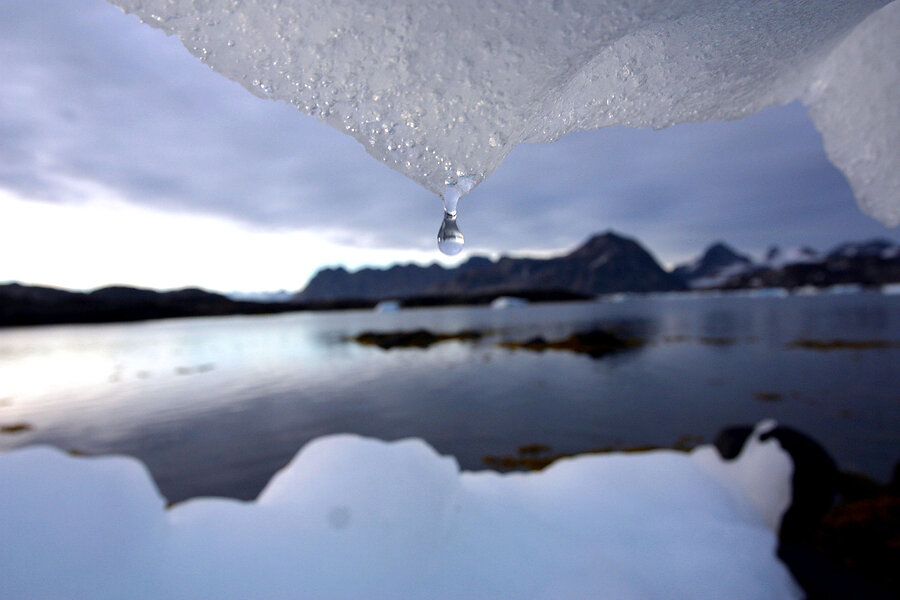Reservoir found under Greenland's snow. What it means for shrinking glaciers.
Loading...
Scientists have discovered a vast reservoir of fresh water captured in layers of old snow buried near the surface of Greenland's vast ice sheet.
The reservoir, located in southeastern Greenland, is similar to a subsurface aquifer found on land. Its water remains liquid all year and covers an area about half the size of New York State.
Scientists can only theorize on why the water remains liquid year-round. But, researchers say, its surprising discovery could help scientists improve their estimates of how Greenland’s ice sheet, which has been losing mass at an increasing pace over the past two decades, will respond to global warming.
The pace of ice loss has accelerated quickly. The loss averaged 121 billion tons a year between 1993 and 2005, according to the Intergovernmental Panel on Climate Change. That pace increased to 229 billion tons a year between 2005 and 2010. Over the past two decades, the losses have raised average sea levels by 0.34 inches.
Scientists made the discovery in April 2011 as part of a three-year program known as Arctic Circle Traverse. The goal was to determine how much snow has fallen on Greenland over the past 30 to 60 years and how global warming has affected the rate of accumulation. The island's ice sheet results from the accumulation and compression of snow to form the ice, so understanding what gets added over time feeds into calculations of gains or losses to the ice sheet's overall mass.
At the end of April 2011, a small team from the University of Utah and the Byrd Polar Research Center at the Ohio State University in Columbus, were extracting core samples from the surface of the ice sheet in southeastern Greenland when they hit a layer of waterlogged snow. The layer appeared 33 feet below the surface in a region of compacted snow known as firn. The water filled the spaces between the snow grains.
The waterlogged layer prevented further drilling at the site, so the team moved about 2 miles east and tried again. They hit water-laden firn again, although this time at a depth of 82 feet. The scientists used ground-penetrating radar to look beneath the surface for additional watery deposits and found a continuous layer of water between the two drill sites and beyond.
At the same time, NASA flew over the area with a specially equipped aircraft during Operation Ice Bridge, a program designed to fill a data-gathering gap left between the demise of ICESat, an ice monitoring satellite that operated from 2003 to 2009, and the launch of its successor, ICESat-2 in early 2016. The aircraft's radar found that the reservoir extended far beyond the area the Arctic Circle Traverse team had covered.
“This discovery was a surprise,” said Rick Forster, a University of Utah geographer who was part of the four-person team that made the discovery. Dr. Forster is the lead author of a paper describing the discovery that appears in the current issue of the journal Nature Geoscience.
The team discovered the reservoir before the summer melt season begins, which meant that the water remained liquid through the ice sheet's frigid winter.
Other teams had noted that even in winter, streams originating at the edges of the ice sheet can flow freely, suggesting a source of liquid water within the cap even in the dead of winter.
Some suggested that the water could come from moulins, circular shafts up to 30 feet wide that summer melt water can drill into the ice sheet. Moulins are thought to be one kind of pipeline that can deliver melt water to the base of the cap, where it can lubricate the underside of the ice to accelerate the movement of the cap's outlet glaciers as they slide toward the sea.
Others had suggested that firn also could serve as sources for the water running through streams in winter.
Yet "no one had yet reported observing water in the firn that had persisted through the winter,” Forster said in a prepared statement.
The international team reporting the results suggests that the water in the firn, summer melt water that has percolated down through layers of snow, can remain liquid because the layers of snow above it insulate the firn from the bitingly cold air temperatures during a Greenland winter.
Although it's unclear how much water the newly-found reservoir holds, the potential storage capacity of firn layers that extend to higher elevations on the ice sheet as climate warms is considerable
Based on its own field studies on the ice sheet, a team led by University of Montana glaciologist Joel Harper last year estimated that the potential storage capacity of firn is enormous – from 322 billion to more nearly 1.3 trillion tons of water.
The fate of the water, however, is unclear. Year-round firn aquifers could serve as additional lubricant that could accelerate ice loss. Or it could slow the pace at which melt water adds its volume to sea-level rise.
Even then, portions of the ice sheet at lower altitudes and firn-free "will experience enhanced melt, too, and this run-off will occur without lag," he writes in an e-mail. "The increased melt from these lower zones will exceed the stored melt from the firn zones," so Greenland's overall contribution to sea-level rise will continue to increase.







